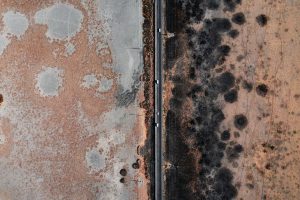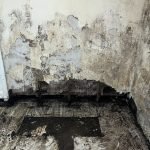
What is White Mold?
Mold is a common danger that can easily affect anyone in their home or workplace. Most people are familiar with black mold but fewer are aware of white mold and the threats it presents. Just like black mold, though, white mold is a toxic fungus that needs to be addressed as soon as possible if you find it in your vicinity.
So What is White Mold?
Despite its name, white mold can appear as a white, grey, or green powdery fungus depending on the surface it’s growing on. It includes multiple fungal species like penicillium and aspergillus.
Regardless of the species of white mold, you’ll commonly find it in high moisture areas of a building. That means basements, bathrooms and showers, attics, and crawl spaces are all strong contenders for an outbreak. Within those spaces, the mold will typically grow on wood or drywall. It lives on the cellulose in those surfaces.
Unfortunately, white mold can be hard to detect when it is first developing. It’s not until colonies form that the mold can be seen with the naked eye. The mold spreads in cool weather when the white mold fungus releases spores. The wind then carries the spores until they reach a surface where they can grow, like the ones in your home.
What Does White Mold Look Like?
White mold can have a variety of appearances and textures, all depending on the type of fungus present, its environment, and the material it is growing on. Generally speaking, white mold is typically white to light grey in color with a fuzzy or powdery texture. It may also be slimy or look like cobweb-like filaments when growing in high humidity areas such as bathrooms or basements.
In certain cases it may even appear yellow or greenish due to other materials it has come into contact with. If you suspect you have white mold in your home, you should take proper precautionary measures to protect your family’s health and get rid of the mold as soon as possible.
Is White Mold Dangerous?
Make no mistake, white mold has its health risks, but it’s just as dangerous as any other color of mold. Continued exposure to any kind of mold can pose a serious threat to your health with symptoms including headaches, nausea, dizziness, allergies, and respiratory infections. Anyone with asthma is at additional risk for white mold symptoms.
In more serious cases, mold exposure can cause long-term issues like memory loss and depression. The more time you spend around mold, the greater the risk that you will suffer negative health effects. So, it’s important to take care of any white mold as soon as you see it.
White mold also presents a more indirect threat: compromising the structural integrity of your building. It is common to find white mold on wood in homes. The mold survives by eating away at the surfaces it’s on such as support beams or other essential components of a property.
Left alone for enough time, and the entire structure may become unstable and unsafe. Yet another reason to deal with white mold quickly.
White Mold Symptoms
White mold is a type of fungus that can cause health issues for individuals, with symptoms ranging from skin irritation, coughing fits, and limited breathing. The severity of the symptoms depends on the amount of mold spores people are exposed to and their own sensitivity levels. Common signs include respiratory problems such as sneezing, watery eyes, dizziness, asthma attacks and even fever.
Persons who come into direct contact with white mold may also experience dry patches on their skin accompanied by itchiness or burning sensations. It is wise to take measures to limit exposure if you notice these symptoms in yourself or another person. Identifying the source of the problem is essential in controlling white mold growth and preventing further damage to health and wellbeing.
Professional Mold Remediation
In situations where the mold growth is extensive, or if individuals with health conditions are present, it is highly advised to solicit the help of professional mold remediation services. Professionals have the necessary training, equipment, and experience to manage large-scale mold problems, ensuring that the mold is not only removed but that steps are taken to prevent its recurrence.
They also ensure the safe removal of mold without causing additional spore dispersion which can lead to further contamination. Trusting the professionals with mold remediation guarantees the most thorough solution with minimal risk to personal health and property integrity.
Frequently Asked Questions About White Mold
How do I know if something is white mold?
Many people confuse white mold with mildew or efflorescence, both of which are less dangerous. If you want to be sure you’re dealing with white mold, you just have to ask yourself a couple of questions.
First, does the substance dissolve in water? If you drop some water on the white substance you suspect is mold and it dissolves, it isn’t mold. It’s probably efflorescence, a salt deposit.
Second, where is the substance growing? As mentioned previously, white mold will typically grow on wood or other building materials.
Mildew, on the other hand, will generally grow on plants and not much else. You’ll usually find efflorescence on hard surfaces like brick and concrete. So, just by looking at the location of the white substance, you should be able to tell what you’re dealing with.
How is white mold different from black mold?
Much like white mold, black mold thrives in high moisture areas and is typically found on porous materials like wood and drywall. The most obvious difference between white and black mold is the color. While white mold ranges in color from white to light green, black mold shows up as a dark green or black color. Black mold is more difficult to remove than white, too.
Beyond that, black mold is known for being particularly dangerous. Toxic black mold is neurotoxic, meaning it’s capable of killing brain cells and causing permanent damage. Some of the symptoms of black mold exposure are the same as white mold exposure like anxiety and memory loss but it can also cause other symptoms including seizures, pulmonary edema, and aggression.
Whether you’re dealing with white or black mold, it’s a problem you should take care of immediately. And if you want to learn more about black mold and the dangers it presents, check out Black Mold: An Introduction to Prevention and Identification.
Is White Mold on Wood Dangerous?
The white mold on a wooden table or floor is potentially dangerous because it will eventually eat away at the wood and cause severe damage. To prevent this from occurring, you can wet an clean cloth in vinegar for up to three days before placing over affected area- if needed longer then just replace constantly!
What Does White Mold Look Like on Wood?
White mold on wood typically appears as a powdery, fluffy, or fuzzy growth. It can be mistaken for other types of mold or mildew, but it has distinct characteristics. The mold is usually white, off-white, or light gray in color. It often has a soft, cotton-like or woolly texture. As it matures, it can darken in color, transitioning to a light brown or yellowish hue.
It tends to spread outwards in irregular, patchy patterns on the wood’s surface. When examining wood for white mold, it’s essential to also be on the lookout for a musty or damp odor, as this is a common sign of mold presence. Prompt removal and addressing the moisture issue that’s causing the mold growth are crucial for preventing further damage.
How can you tell if mold is toxic?
Any kind of mold, including white mold and black mold, can be toxic and dangerous to your health. If you find mold in your house or workplace, you should do something about it as quickly as possible to protect yourself. And if you’re already experiencing symptoms consistent with toxic mold exposure (coughing, fatigue, rashes, and more), you should call a doctor and a professional mold removal company.
The longer you’re exposed to the mold, the greater the chance that you will suffer long-term health effects. That’s not a risk worth taking.
Mold Remediation Professionals
White mold is a household threat you might not have been aware of previously. It grows on wood and drywall and can present serious health risks to those exposed to it. Don’t mess around with mold. Consider contacting a professional like Jenkins Environmental Services for help.
[otw_shortcode_button href=”/request-help/” size=”medium” icon_position=”left” shape=”square”]Get Professional Mold Removal and Remediation help today![/otw_shortcode_button]




